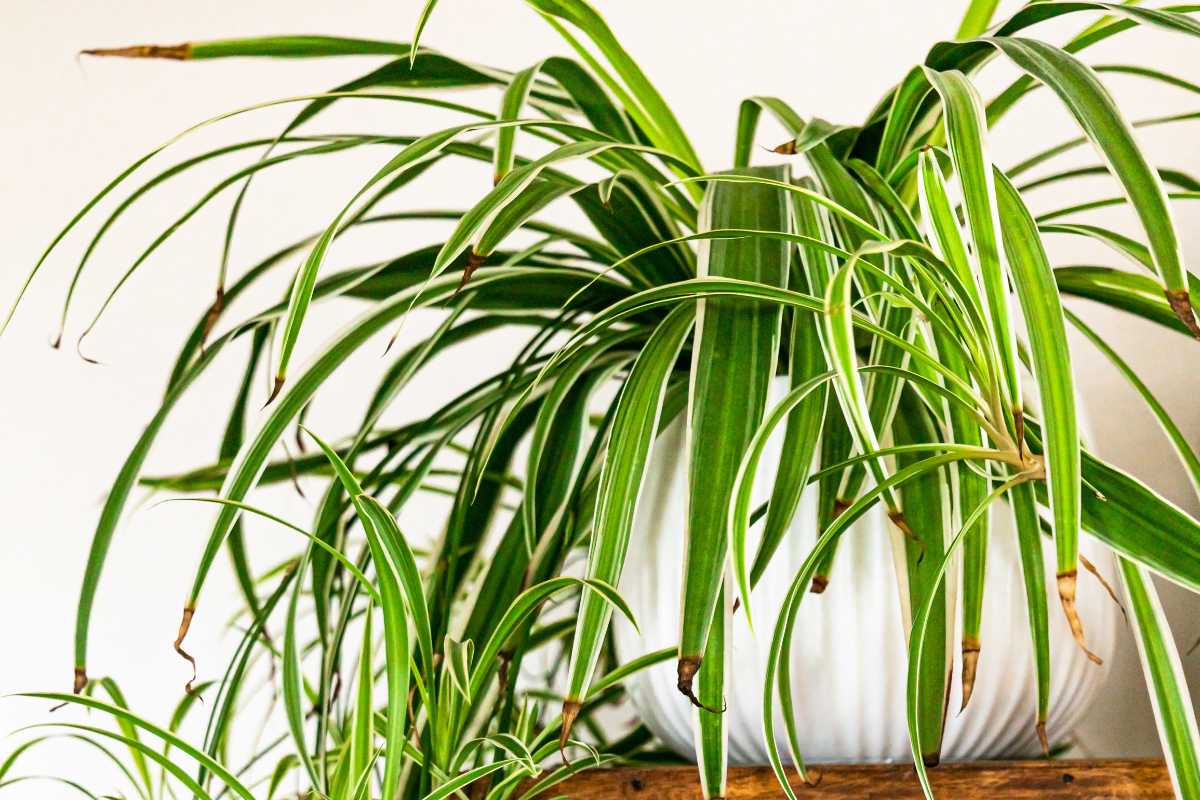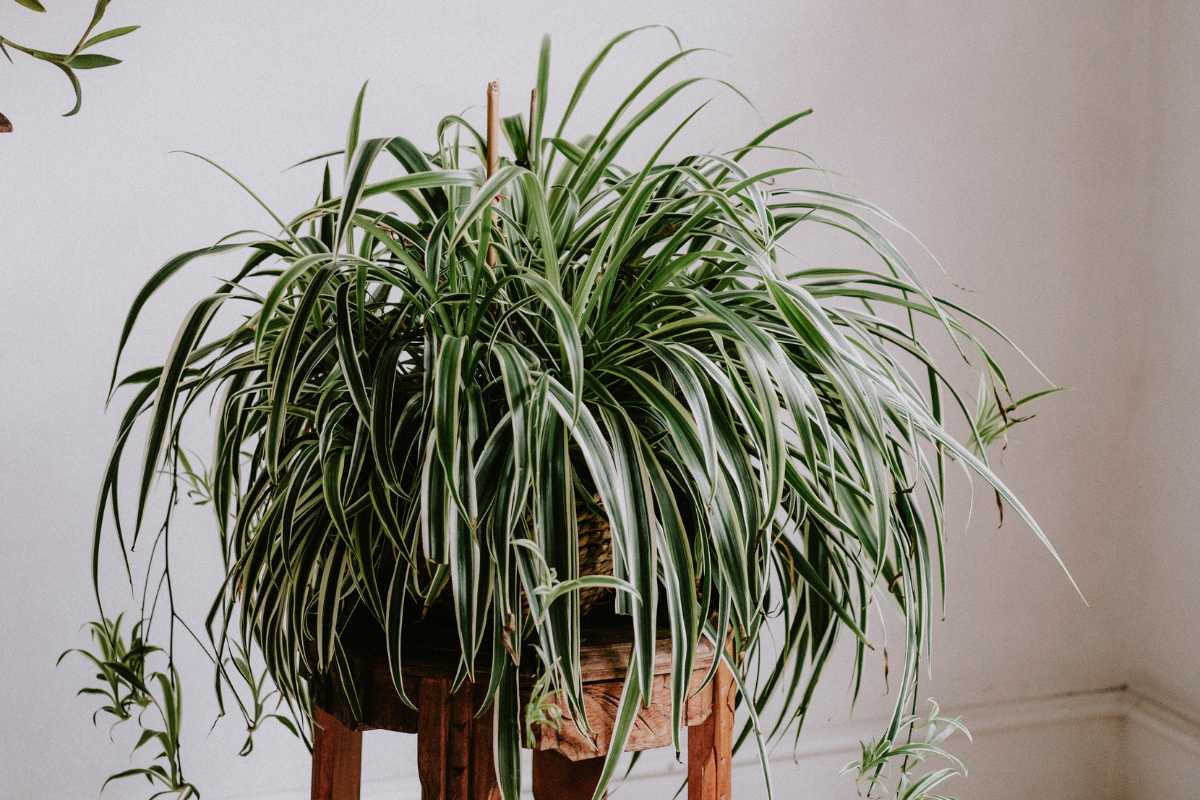Chlorophytum Comosum, commonly known as spider plant, is a beloved houseplant for good reason.
It is also known as the airplane plant or the ribbon plant. Spider plants usually start off as white flowers that soon blossom into spider-leg-like leaves.
Once they are fully grown, not only are they attractive, but they are also easy to maintain. Propagating these plants is such an ease.
Spider plants are also hardy houseplants and can tolerate a wide range of environmental conditions. Along with the benefit of purifying air.
You’ll be glad then that spider plants aren’t poisonous to dogs, even if they can cause some vomiting or diarrhea if ingested.
Your dogs, on the other hand, can be very harmful to spider plants, especially if they decide to urinate on them.
- Related article: Spider Plant How to Grow Guide
All in all, it’s a good idea to keep your spider plants away from your furry friends to avoid any inconvenience. Let’s discuss this better.
Are Spider Plants Poisonous to Dogs?

Spider plants are reportedly not toxic to dogs, according to the ASPCA (American Society for the Prevention of Cruelty to Animals).
However, feeding off of the airplane plant can still cause serious digestive problems to your dogs.
Other pet-friendly plants to have around the house are:
- Areca palm (Dypsis lutescens) – this plant loves a south- or west-facing window with indirect light
- Ponytail palm (Beaucarnea recurvata) – isn’t a true palm but this indoor tree is easy to grow and loves bright light
- Air plants – these epiphytes don’t require soil to grow
- Boston fern – a beautiful fern has a feather-like quality, keep this out of bright direct light
- Prayer plants – this non-toxic plant is suited for those who like foliage color
- Rubber plant – a glossy plant with succulent-like leaves, a great addition to a dog-loving home
- Haworthia – non-toxic succulent with fleshy green leaves
These safe plants are a favorite among pet owners as they can easily co-exist with their fur babies.
Much like when they eat grass, dogs will often vomit after ingesting greens. This shouldn’t be a cause for concern, at least not for the dog. Their digestive systems haven’t evolved to digest grass, so their bodies end up rejecting it.
There’s a theory that they eat greens specifically for this reason. It can help them cleanse their system of harmful substances.
Dogs could also simply be attracted to these indoor plants out of boredom, or they might like the smell. You shouldn’t be fooled by the fact that you can’t detect any particular fragrance, as dogs have a very powerful sense of smell.
It should be noted that some dogs could experience vomiting and diarrhea as an adverse reaction to some compounds found in spider plants that are similar to opiates. It is quite rare, but some hypersensitive animals could be affected in this way.
You shouldn’t worry too much though, as this is not a sign of toxicity. Still, if a dog ingests large amounts of the plant, it’s best to take a trip to the vet.
Once they get used to it, it will be more difficult to teach them not to and your spider plants certainly wouldn’t appreciate being continually munched on.
Spider Plants and Dogs

Having established that these common plants aren’t toxic to your pets, you might wonder how damaging your dogs can be for them.
Puppies are certainly the most dangerous, as their endless curiosity and playfulness can easily lead to them uprooting plants or damaging them in some other way.
When dogs chew on the leaves of these common houseplants, they leave open wounds that attract pests and increase the risk of infection.
So even if they only eat a small amount, this can still cause major issues for the plant.
The real danger though is the dog’s urine. Yes, plants need nitrogen to thrive but anything in excess is not good and the concentration of nitrogen in a dog’s urine is something that a plant cannot tolerate.
How to Keep Spider Plants Away From Dogs

The easier solution to protect your dogs (and your spider plants) is simply to move them to an unreachable location. Or try moving it outside as an outdoor plant where your pet does not go.
If you have potted spider plants that risk getting peed on, you could consider repotting them into hanging baskets and placing them high up on a shelf or a hook.
They will look quite lovely with the leaves cascading down.
Of course, you could also train your dog to avoid the plant. The trick is to always remain consistent in reprimanding them every time they nibble or pee on your plant so they can develop discipline and stay away from it.
If training doesn’t work, a more extreme solution would be to place protective covers on your spider plants. Choose one that lets air and sunlight through; a birdcage would be perfect for instance.
If you find this unattractive, simply place the spider plants in a room where your dogs won’t enter. The bathroom is especially suited to house these plants because of its high humidity.
Some people advise spraying the leaves of spider plants with something bitter to discourage munching. However, always be careful what substances you use, since introducing something new to your dog’s diet could harm him, even if it seems innocuous.
Ultimately, the best solution will depend on the reason why your dog is bothering the plants. It could simply be that he’s bored and looking for some stimulation.
So spending more time walking and playing with your pet could ensure that he will lose interest in your house plants.
You could also invest in some toys that will challenge your dog and keep him busy for long periods when you can’t keep him company. This way, everybody wins.
Final Thoughts If Spider Plants Are Toxic to Dogs
Spider plants are a popular houseplant choice because they are not toxic to most pets. However, with less caution, they can still cause your pet harm.
To keep both your favorite plants and pet safe, try to train your dog to stay away from the plants or move your plants to a location where your dog won’t be able to access them.
Sometimes, dogs play with plants because they lack attention. Maybe it’s time you give your fur babies some love.
There is no harm in bringing a bit of nature into your indoor environment. Just make sure you choose the right type of plant that can also co-exist with your pets.
If we got you curious, check out these other awesome articles about spider plants:

